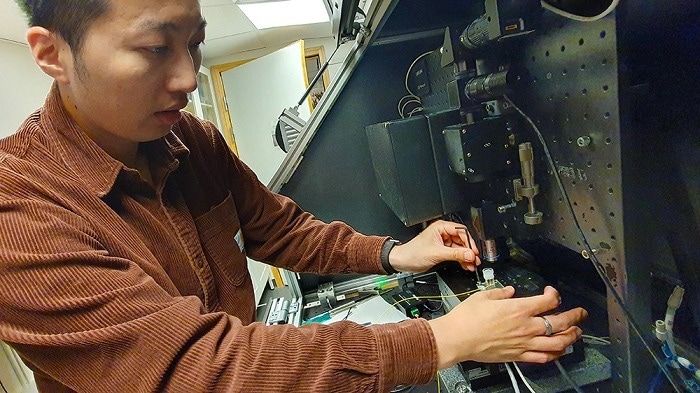According to a study published in the journal ACS Nano, researchers at KTH Royal Institute of Technology in Stockholm 3D-printed silica glass micro-optics on the ends of optic fibers—surfaces as tiny as the cross-section of a human hair. This advancement could result in faster internet and better connections, as well as smaller sensors and imaging devices.

Lee-Lun Lai demonstrates the setup for printing silica glass microstructures on an optical fiber. Image Credit: David Callahan
The integration of silica glass optical devices with optical fibers opens avenues for multiple innovations, including the development of more sensitive remote sensors for environmental monitoring and healthcare applications.
Additionally, the printing techniques detailed in the study hold potential value for enhancing the production processes of pharmaceuticals and chemicals.
According to KTH Professor Kristinn Gylfason, the method addresses longstanding challenges associated with structuring optical fiber tips using silica glass. Traditional methods often require high-temperature treatments that can compromise the integrity of temperature-sensitive fiber coatings.
In contrast, this new process begins with a base material devoid of carbon, eliminating the need for high temperatures to remove carbon and achieve glass transparency.
The authors have filed a patent application for the technique.
More Resilient Sensors
Lee-Lun Lai, the study’s lead author, says the researchers printed a silica glass sensor that proved more durable than a normal plastic-based sensor after several assessments.
We demonstrated a glass refractive index sensor integrated into the fiber tip that allowed us to measure the concentration of organic solvents. This measurement is challenging for polymer-based sensors due to the corrosiveness of the solvents.
Lee-Lun Lai, Study Lead Author and Doctoral Student, KTH Royal Institute of Technology
The study’s co-author, Po-Han Huang, added, “These structures are so small you could fit 1,000 of them on the surface of a grain of sand, which is about the size of sensors being used today.”
The researchers also demonstrated a method for printing nanogratings, which are ultra-small patterns etched onto surfaces at the nanometer scale. These nanogratings are employed for precise light control and hold potential applications in quantum communication.
According to Gylfason, new possibilities in photonics could be explored by 3D printing any type of glass structure directly on the fiber tip.
By bridging the gap between 3D printing and photonics, the implications of this research are far-reaching, with potential applications in microfluidic devices, MEMS accelerometers and fiber-integrated quantum emitters.
Kristinn Gylfason, Professor, KTH Royal Institute of Technology
The authors acknowledge the following competing financial interest: The techniques and optical applications discussed in this study have been covered by a patent application (US 17/171,587) submitted by L.L., P.H., G.S., F.N., and K.B.G. as inventors and applicants.
Journal Reference:
Lai, L.-L., et. al. (2024) 3D Printing of Glass Micro-Optics with Subwavelength Features on Optical Fiber Tips. ACS Nano. doi:10.1021/acsnano.3c11030